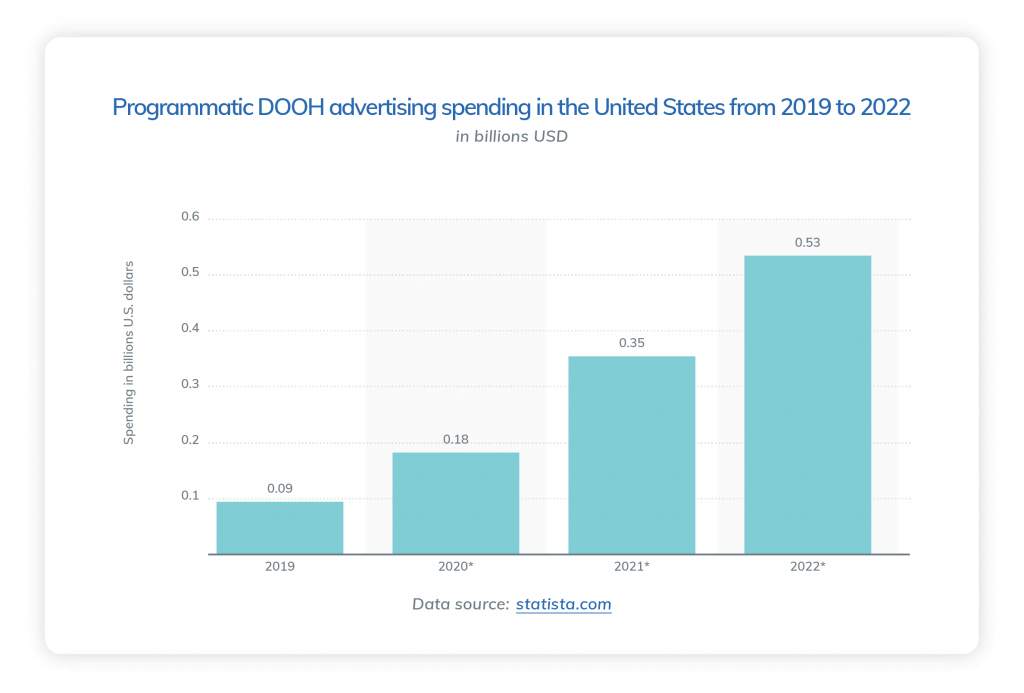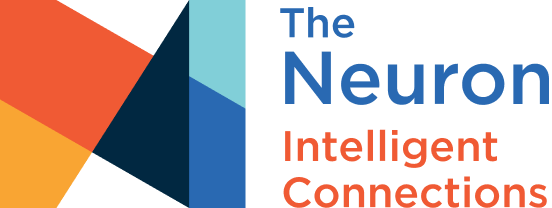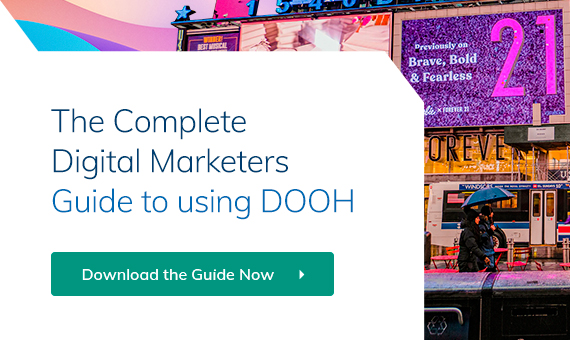Programmatic digital out of home advertising (abbreviated to programmatic DOOH or pDOOH) is a relatively new way for advertisers to reach mass audiences whilst targeting key consumers more effectively.
Marketers and advertisers are becoming increasingly aware of the flexibility, efficiency and audience targeting advantages pDOOH offers, with both major brands, agencies and small to medium sized companies seeing pDOOH as a huge growth area over the next few years.
The global digital-out-of-home advertising market reached a value of US$ 41.06 bn in 2020, but predicted growth is expected to reach a value of $50.42bn by 2026. Programmatic DOOH will make up an increasing percentage of digital out of home spend.
By 2022, pDOOH will make up nearly 14.8% of DOOH spend in comparison to 3.2% in 2019 – that’s nearly a five-fold percentage increase in just three years.

Image source: statista.com)
Why are brands turning towards this new approach to digital out of home advertising and what could it deliver for your business?
We explore the major attractions of pDOOH below.
DOOH Advertising Examples and Types of Programmatic Advertising
To really understand where programmatic DOOH could take you, it’s important to understand what the term means and how it relates to other types of OOH advertising.
‘Programmatic advertising’ refers to any sort of digital advertising bought via an automated software platform, rather than traditional media buying processes. This opens up the possibility of buying ad space under specified conditions, allowing buyers to bid on space based on key criteria, like views, clicks, or footfall.
You might be familiar with this method of digital media buying – its usually how online advertising is bought and sold. Now, DOOH inventory like digital billboards in town centers and other public places is being sold in this way too.
For example, as reported by eMarketer, Campbells Soup launched a successful pDOOH campaign based around temperature. They specified that their ads should only go live when the temperature dipped below a certain point to increase their product’s appeal to potential customers.
Elsewhere, Simon de Beauregard, who was Director of Engagement at Pernod Ricard for the Absolut, Malibu, Kahlúa and Smithworks labels, said that programmatic outdoor ad buying is appealing “because it offers more flexibility than traditional OOH.” Pernod Ricard uses triggers like happy hour times and temperatures to determine when to programmatically purchase outdoor inventory for its alcohol brands, for example.
What Does Programmatic DOOH Offer Media Buyers?
There are three key areas where pDOOH delivers in comparison to traditional media buying practices:
1. Flexibility
Programmatic DOOH enable buyers to purchase inventory automatically which makes it easier and faster than the traditional OOH media buying process.
As well as saving marketing and advertising departments hours of back and forth with third-party media agencies (and opening up DOOH to a wider range of businesses as a result), this immediately makes your campaign more flexible and reactive.
Imagine a sports bar being able to trigger their creative based on the final score, so they can adjust their message to local fans accordingly. Or a hot drinks brand being able to get DOOH ads out immediately upon announcement of upcoming poor weather.
Programmatic DOOH allows you to make large scale, mass-audience advertising more relevant, dynamic and reactive than ever before.
2. Extra Visibility Via Targeted DOOH
OOH in general is a great way of reaching people when they are open to receiving new messages.
According to The Drum, unaided recall rates for OOH stand at 40% and digital OOH is even higher at 47%. These clearly surpass more invasive channels like mobile and TV (35% and 22% respectively).
Programmatic DOOH takes that visibility a step further by allowing you to target the audiences that matter most. If you can specify the conditions under which your creative is displayed, you’re much more likely to hit the audiences you want to buy.
So, as well as targeting by location, you can specify that you only want your ad shown on particular dates, days of the week, weather conditions, or when foot traffic surpasses a certain amount (based on smartphone GPS data). This means that your ads are only shown when there is a receptive audience for them.
In other words, you combine the mass visibility of public advertising with a new, targeted approach that in turn, increases your ROI.
3. Real-time Metrics and Reporting at a Glance
The major drawback of traditional OOH is that there is no precise way to understand whether your ad campaigns have been successful.
Now with digital OOH you can:
- Access dashboards that drive speed and flexibility allowing you to execute campaign optimization on-the-fly and react and be proactive when it comes to any changes.
- Check planned and spent budgets by campaign, publisher, and creative.
- Access audience information and # of impressions delivered.
- Obtain individual screen delivery and performance results – # of playouts.
- Obtain eCPM information.
- Get reports by day/week/month.
- Track initial response to your OOH campaign by comparing marketing data with campaign reports and learn in real time what’s working and what’s not.
Whilst you might be able to track these metrics in a traditional DOOH campaign, programmatic DOOH demand-side platforms provide the opportunity to react to these metrics in real time. You can therefore take a truly data-driven approach and tailor your DOOH ad campaigns for optimum success – something that’s nearly impossible to do with traditional reporting methods.
Find a Reliable Programmatic DOOH Platform
If you want your programmatic DOOH campaign to deliver, you need to find an automated platform that’s reliable, easy to use and extensive.
The Neuron connects media buyers directly with media owners, so you can find something that suits your objectives quickly, with no need for third-party involvement.
With an easy-to-use interface and simple bidding process, you can set your creative live in a matter of clicks and track how your campaign is performing through planned and spent budgets by campaign, advertiser, seller and agency; audiences and the number of impressions delivered; individual screen delivery and performance; reports by day, week or month and of course, eCPM.
With packages to suit both agencies and SMBs, The Neuron is an ideal platform for experienced media buyers and newcomers alike.

